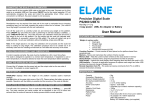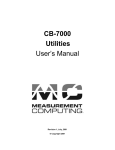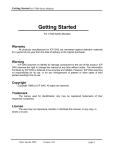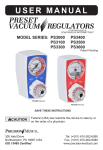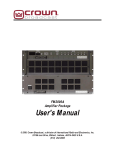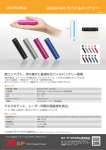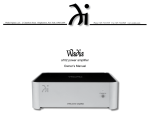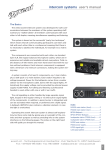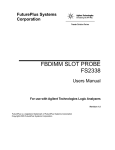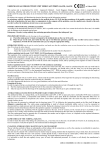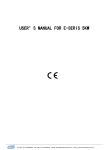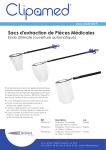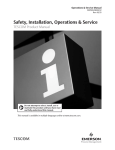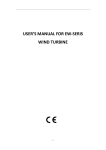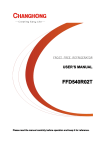Download DP60-120_DP180_manual
Transcript
OUTPUT TO SPEAKER A User’s Manual EQUAL. FILTER CH B OVER FLAT 1+ LOW+ 1- LOW2+ HIGH+ 2- HIGH- max min LEVEL DYNAMIC PROCESSOR INPUT FROM AMPLIFIER 1+POS 1-GND CH A 2+POS 2-GND CH B PUSH 3 DP 60-120 Cross Fire ON PROCESS BY-PASS SOUND REINFORCEMENT CONTROLLED RADIATION 1 1 3 OUTPUT TO SPEAKER B INPUT FROM AMPLIFIER 1+ LOW+ 1- LOW2+ HIGH+ 2- HIGH- 1+POS 1-GND CH B INK INPUT XLR BAL 1=GND 2=HOT+ 3=COLD- PUSH 1 3 2 2 1 3 OUTPUTL DP60-120, DP180 2 2 OUTPUTL POWER CH A DP60-120, DP180 1 USER’S MANUAL ACOUSTIC RESEARCH INK INPUT CH B OUTPUT TO SPEAKER A User’s Manual EQUAL. FILTER CH B OVER FLAT 1+ LOW+ 1- LOW2+ HIGH+ 2- HIGH- INPUT FROM AMPLIFIER 1+POS 1-GND CH A 2+POS 2-GND CH B PUSH DYNAMIC PROCESSOR 1 3 DP 60-120 Cross Fire ON BY-PASS 2 2 OUTPUT TO SPEAKER B INPUT FROM AMPLIFIER 1+ LOW+ 1- LOW2+ HIGH+ 2- HIGH- 1+POS 1-GND CH B INK 3 2 2 1. IMPORTANT SAFETY INSTRUCTIONS pag. 3 2. DECLARATION OF CONFORMITY pag. 3 3. WARRANTY pag. 3 4. USER LIABILITY pag. 4 4.1 Dangerous output voltage 4.2 Radio interferences pag. 4 5.1 Unpacking 5.2 Installation 5.3 Front panel 5.4 Rear panel pag. 6 6.1 Connection cables 6.2 Power supply 7. DEVICE DESCRIPTION pag. 6 7.1 Functional features 7.2 Controls and functions SOUND REINFORCEMENT 8. SETUP pag. 7 9. SAMPLE CONFIGURATION pag. 7 10. TECHNICAL SPECIFICATIONS pag. 8 CONTROLLED RADIATION 2 XLR BAL 1=GND 2=HOT+ 3=COLD- 1 3 INK TABLE OF CONTENTS 6. CONNECTIONS INPUT PUSH 1 OUTPUTL 5. INTRODUCTION 1 3 OUTPUTL POWER PROCESS CH A DP60-120, DP180 max min LEVEL ACOUSTIC RESEARCH INPUT CH B OUTPUT TO SPEAKER A User’s Manual EQUAL. FILTER CH B OVER FLAT 1+ LOW+ 1- LOW2+ HIGH+ 2- HIGH- max min LEVEL DYNAMIC PROCESSOR INPUT FROM AMPLIFIER 1+POS 1-GND CH A 2+POS 2-GND CH B PUSH 3 DP 60-120 Cross Fire ON PROCESS BY-PASS OUTPUT TO SPEAKER B INPUT FROM AMPLIFIER 1+ LOW+ 1- LOW2+ HIGH+ 2- HIGH- 1+POS 1-GND CH B INK INPUT XLR BAL 1=GND 2=HOT+ 3=COLD- PUSH 1 3 2 2 1 CH B 3 INK INPUT 3. WARRANTY This symbol indicates key operating instructions and information requiring particular attention for correct use of the product. Peecker Sound products are guaranteed against malfunction due to defective materials or workmanship for a specified period of time, starting from the date of original purchase. Should a malfunction occur during the warranty period, the product will be repaired or replaced (at the manufacturer’s discretion) free of charge. The shipping costs and related risks, and any loss during shipment to authorized service centres are the responsibility of the customer. The product will be returned to the customer with a carriage forward shipment. This symbol warns of dangerous voltage and the consequent risk of electric shock. Take extra care and proceed with caution. Warranty terms The warranty covers the appliance under its initial purchase in compliance with the laws in force. The warranty is valid for 3 years, starting from the date of receipt of the product. Peecker Sound reserves the right, in certain cases, to decide to replace the appliance with another identical or similar product. The warranty is not extended following a product failure. The warranty does not cover any incidental or consequential damages, without limitation, caused to persons or property during any period of inefficiency of the appliance. 1. Read carefully all the attached product documentation and keep for further reference. 2. Heed the warnings. 3. Keep the packaging and check that all the material is in perfect condition. 4. Do not use the product in the vicinity of water or pour water or any other liquid on the processor. Take care not to use it with wet hands or with your feet in water. 5. Do not use near sources of heat such as radiators, stoves or other heatproducing appliances. 6. Check that the power cable is intact and undamaged. Do not tread on the cable and take care not to put any pressure on the plug. 7. Connect the plug to a properly earthed electric socket. Do not tamper with the plug. Should the plug supplied not fit your socket, have an electrician replace it with the correct one. 8. Connect to the mains supply having identical voltage as that indicated on the back of the processor. 9. Install the processor in compliance with the instructions. 10.Disconnect the appliance in case of storms or when not in use. 11.Wire exclusively as shown in the instructions. 12. Do not remove the upper or lower covers as this would expose the user to the risk of electric shock. Exclusions and limitations The warranty does not apply to: • any damage to exterior finishings or surfaces, aesthetic elements, or electric/ electronic parts resulting from negligent use of the product; • malfunction resulting from incorrect or improper use of the product or from transport without due care; • malfunction resulting from repairs carried out by unauthorized persons or service centres; • malfunction due to circumstances that cannot be ascribed to manufacturing defects of the appliance; • plastic or glass parts, bulbs and the like, as well as all that can be regarded as normal wear and tear. As regards circuit components (transistors, diodes, etc.) the general terms set by the original manufacturers apply. The following are also not covered by the warranty: • damage caused by accidents, product modifications, negligence or incorrect connection • damage that occurred during transport • damage resulting from failure to comply with the instructions contained in the user’s manual • claims based on misrepresentations by the seller and any product whose serial number has been rubbed off, modified or removed. 13.Do not attempt to repair the appliance yourself but always seek the assistance of qualified technicians. 14. Clean with a dry cloth only. 15.The product must be handled by qualified technicians when: • the power cable or the plug is damaged • the product has been exposed to rain or humidity • liquid has got inside the unit • an object has fallen on the unit • the unit has fallen and is damaged • the appliance seems to be malfunctioning or is showing a marked change in performance 16. Careful supervision is required if the product is used in the presence of children or by unskilled adults. Receiving warranty service To receive repair or replacement of the product under warranty, the customer must deliver the product in its original packaging carriage paid to an authorized Peecker Sound service centre together with the relevant proof of purchase, i.e. bill of sale, receipt or invoice. The warranty service and list of authorized service centres is available at the address below: Peecker Sound - “After Sales Service” Via Monti Urali, 29 - 42100 Reggio Emilia (Italy) Tel: +39 0522 557735 - Fax: +39 0522 391268 E-mail: [email protected] 2. DECLARATION OF CONFORMITY Repair or replacement of the product and its return to the customer are the only services provided to the customer. Peecker Sound shall not be held liable to pay incidental or consequential damages including, without limitation, injury to persons or property or loss of use. This device complies with the requirements of the European Electromagnetic Compatibility Directive 89/336/EEC (and relevant 92/31/EEC amendment),as well as the requirements of the Low Voltage Directive 72/23/EEC (and relevant 93/68/EE amendment). Regulations applied: EN 55 103-1 (Emissions) EN 55 103-2 (Immunity) EN 60065 Class I (Safety) SOUND REINFORCEMENT 1 3 OUTPUTL 1. IMPORTANT SAFETY INSTRUCTIONS 2 2 OUTPUTL POWER CH A DP60-120, DP180 1 Costs paid by Peecker Sound Peecker Sound will pay for all labour and material expenses necessary for the repairs covered by the warranty. Make sure you keep the original packaging; otherwise, the cost of replacing will be charged to you if necessary. Produce the original invoice to establish the date of purchase. Do not send the product to the factory without prior authorization. Should shipment of the product be a problem, please contact the service centre, who will deal with it promptly. Otherwise, the customer is responsible for shipment and handling of the product to be repaired and payment of all shipping costs. CONTROLLED RADIATION 3 ACOUSTIC RESEARCH OUTPUT TO SPEAKER A User’s Manual EQUAL. FILTER CH B OVER FLAT INPUT FROM AMPLIFIER 1+ LOW+ 1- LOW2+ HIGH+ 2- HIGH- 1+POS 1-GND CH A 2+POS 2-GND CH B PUSH DYNAMIC PROCESSOR 1 3 2 2 DP 60-120 Cross Fire ON BY-PASS OUTPUT TO SPEAKER B INPUT FROM AMPLIFIER 1+ LOW+ 1- LOW2+ HIGH+ 2- HIGH- 1+POS 1-GND CH B INK INPUT XLR BAL 1=GND 2=HOT+ 3=COLD- PUSH 1 3 2 2 1 3 OUTPUTL Limitation of implicit warranties All implicit warranties, including guarantee of merchantability and suitability to specific purposes, are limited to the duration of the present warranty. With the exception of certain types of damage, Peecker Sound liability is limited to repairing or replacing, at its discretion, any defective products, with no obligation of compensation for any kind of incidental or consequential damages. In case of any controversy, the court of jurisdiction will be exclusively the Court of Reggio Emilia (RE) – Italy. 1 3 OUTPUTL POWER PROCESS CH A DP60-120, DP180 max min LEVEL INK INPUT 5.1 Unpacking Inspect the packaging and its contents immediately to check whether there are any signs of damage. After unpacking, inspect the product and any accessories. Should you notice any damage, inform your dealer immediately. Please keep all the packaging materials, which will be useful for returning the product to Peecker Sound or sending it to one of our authorized Service Centres if the product does not arrive in perfect condition. Use exclusively the original packaging, as it is the best way to protect the appliance from mishandling by the carrier. 4. USER LIABILITY 4.1 Dangerous output voltage Please take care of the environment. Once the device has become obsolete, please dispose of it in the appropriate recycling container. Do not touch exposed speaker cables while the processor is operating. 4.2 Radio interferences A sample of this product has been tested and approved in compliance with the limits set out by the Electromagnetic Compatibility Directive (EMC). These limits have been determined in order to provide reasonable protection from dangerous interferences caused by electrical appliances. Should this product not be installed or used in compliance with the instructions as set out in this manual, it might interfere with other appliances such as radio receivers, for example. There is no guarantee, however, that interferences will not occur in a particular installation. 5.2 Installation The Peecker Sound DP60-120 and DP180 Stereo Dynamic Processors have been designed to stand on a surface (e.g. a table) or to be installed in a 19” rack unit. 483 Should the device interfere with two-way radios (switching the device on and off will allow you to check whether this is the case), you should try to eliminate the interference by adopting one of the following measures: A) Increase the distance between the appliance and the receiver. B) Connect the appliance to a socket positioned on a circuit different from the one the receiver is connected to. C) Re-position or move the aerial of the receiver. CH B CH A OVER FLAT FLAT max min LEVEL DYNAMIC PROCESSOR POWER DP 60-120 Cross Fire PROCESS PROCESS ON BY-PASS 374 Figure 1. DP60-120 and DP180 unit dimensions Check that the unit complies with the EMC immunity limits (it must carry the CE mark). All electrical appliances sold in the EU must be approved for immunity to electromagnetic fields, high voltage and radio interferences. Seek for professional assistance. Remember to allow an extra clearing space of 10 cm at the back for the connectors. Do not set the unit directly on top of power amplifiers or power supply units, as the heat and electromagnetic fields produced by these appliances can interfere with correct device operation. 5. INTRODUCTION Congratulations on your choice of Peecker Sound Stereo Dynamic Processors (DP60-120 or DP180) and thank you for your confidence in us and our products. Your device have been carefully engineered down to the smallest detail, from component selection to final assembly. All Peecker Sound products aim for full customer satisfaction and you can rest assured that the product you have chosen uses cutting-edge technology. When moving the equipment with a trolley take extra care not to injure yourself. Please remember that the unit should not be installed in venues with: • High temperatures • Dust or excessive humidity • Intense magnetic fields • Water in the vicinity of the unit • Vibrations • Enclosed spaces that inhibit proper ventilation. The DP60-120 and DP180 Stereo Dynamic Processors have been designed in the Sound Corporation Design and Research&Development (R&D) departments paying particular attention to the choice of materials, safety devices and electronic design for the manufacture of a safe, reliable and longlasting product. Since inappropriate use of the device can jeopardize its correct operating performance, please ensure that you use it carefully and correctly. Please read this manual carefully: all the information it contains is vitally important for using your appliance safely. SOUND REINFORCEMENT EQUAL. FILTER EQUAL. FILTER OVER 88 max min LEVEL CONTROLLED RADIATION 4 ACOUSTIC RESEARCH CH B OUTPUT TO SPEAKER A EQUAL. FILTER User’s Manual CH B CH A 2+POS 2-GND CH B PUSH 1 3 ON PROCESS BY-PASS OUTPUT TO SPEAKER B INPUT FROM AMPLIFIER 1+ LOW+ 1- LOW2+ HIGH+ 2- HIGH- 1+POS 1-GND 1 3 EQUAL. FILTER CH B CH A OVER OVER FLAT FLAT DYNAMIC PROCESSOR POWER DP 60-120 Cross Fire ON BY-PASS 3 4 3 1 Figure 2. DP60-120 front panel 2 2 1. Power - Power switch. 2. Level - Equalization filter level control (for Ch A and Ch B). max min LEVEL EQUAL. FILTER EQUAL. FILTER max min LEVEL 3. Over/Flat/Process - LED indicators in Bprocessing signals (for Ch A and Ch B). CH Ashowing processor actionCH DYNAMIC PROCESSOR OVER OVER 4. By-pass - Switch that enables by-pass of the device. FLAT 8 POWER DP 60-120 Cross Fire FLAT 7 6 5 ON PROCESS PROCESS BY-PASS WARNING: OUTPUT TO SPEAKER A TO REDUCE THE RISK OF FIRE OR ELECTRIC SHOCK DO NOT EXPOSE THIS EQUIPMENT TO RAIN OR MOISTURE. DO NOT REMOVE COVER. 3 S.N. 1+ LOW+ 1- LOW2+ HIGH+ 2- HIGH- 4 CAUTION RISK OF ELECTRIC SHOCK MAINS 230VG 50-60Hz INPUT FROM AMPLIFIER 3 1+POS 1-GND CH A 2+POS 2-GND CH B 5.4 Rear Panel FOR CONTINUED GROUNDING PROTECTION DO NOT REMOVE SCREW PUSH 1 3 MADE IN ITALY OUTPUT TO SPEAKER B INPUT FROM AMPLIFIER 1+ LOW+ 1- LOW2+ HIGH+ 2- HIGH- 1+POS 1-GND CH B 1 3 2 2 CH A XLR BAL 1=GND 2=HOT+ 3=COLD- 1 CH B 3 LINK INPUT 9 8 WARNING: S.N. 7 OUTPUT TO SPEAKER A TO REDUCE THE RISK OF FIRE OR ELECTRIC SHOCK DO NOT EXPOSE THIS EQUIPMENT TO RAIN OR MOISTURE. DO NOT REMOVE COVER. 1+ LOW+ 1- LOW2+ HIGH+ 2- HIGH- CAUTION RISK OF ELECTRIC SHOCK 6 5 INPUT FROM AMPLIFIER 1+POS 1-GND CH A 2+POS 2-GND CH B PUSH 1 3 Peecker Sound MADE IN ITALY OUTPUT TO SPEAKER B INPUT FROM AMPLIFIER 1+ LOW+ 1- LOW2+ HIGH+ 2- HIGH- 1+POS 1-GND CH B 2 2 OUTPUT DO NOT OPEN FOR CONTINUED GROUNDING PROTECTION DO NOT REMOVE SCREW 1 1 3 10 CH A 3 LINK INPUT XLR BAL 1=GND 2=HOT+ 3=COLD- PUSH OUTPUT 11 INPUT PUSH 10 MAINS 230VG 50-60Hz 1 3 LINK OUTPUT 11 1 2 2 OUTPUT DO NOT OPEN Peecker Sound 2 2 1 CH B 3 LINK INPUT 9 Figure 3. DP60-120 rear panel 5. Input - Female Neutrik® XLR input connectors for both channels (Ch A and Ch B). 6. Output - Male Neutrik® XLR output connectors for both channels (Ch A and Ch B). 7. Input from amplifier - Neutrik® SpeakOn input connectors to receive the signal from the amplifiers. 8. Output from speaker - Neutrik® SpeakOn output connectors to send the signal to the speakers. 9. Link - Jack connectors to link different devices. 10. Ground Lift - Ground lift switch allowing connection-disconnection of electrical earth to/from mechanical earth. 11. Mains - Power supply cable with CEE 7/7 Schuko plug. SOUND REINFORCEMENT CONTROLLED RADIATION 5 CH A XLR BAL 1=GND 2=HOT+ 3=COLD- 1 3 max min LEVEL PROCESS PROCESS INPUT 2 2 2 EQUAL. FILTER INK PUSH CH B 5.3 Front panel max min LEVEL 1 3 OUTPUTL 2 2 2 OUTPUTL POWER DP 60-120 Cross Fire FLAT 1+POS 1-GND DP60-120, DP180 DYNAMIC PROCESSOR OVER INPUT FROM AMPLIFIER 1+ LOW+ 1- LOW2+ HIGH+ 2- HIGH- max min LEVEL ACOUSTIC RESEARCH INK INPUT CH B OUTPUT TO SPEAKER A User’s Manual EQUAL. FILTER CH B 1+ LOW+ 1- LOW2+ HIGH+ 2- HIGH- max min LEVEL DYNAMIC PROCESSOR OVER 1+POS 1-GND CH A 2+POS 2-GND CH B PUSH ON PROCESS BY-PASS 3 1 3 OUTPUT TO SPEAKER B INPUT FROM AMPLIFIER 1+ LOW+ 1- LOW2+ HIGH+ 2- HIGH- 1+POS 1-GND CH B INK INPUT XLR BAL 1=GND 2=HOT+ 3=COLD- PUSH 1 3 2 2 1 3 INK INPUT 7. DEVICE DESCRIPTION The Peecker Sound Stereo Dynamic Processors DP60-120 and DP180 are intelligent dynamic processors which make it possible to adapt sound emission to the physiological characteristics of human hearing. Its main function is to coordinate the operation of the speaker-amplifier combination to provide a high performance sound reinforcement system. Check that mains power voltage corresponds to that indicated on the back of the unit. Before connecting the cable to the AC mains, make sure it is undamaged and there are no bare cables. Remember to turn off the processor before connecting it to or disconnecting it from any other units. The DP60-120 is typically used in configurations with Peecker Sound AS60 or AS120 controlled radiation speakers, while DP180 is linked to AS180 speakers. 6.1 Connection cables Input and output wiring diagrams are shown in Fig. 4. Cannon XLR and Neutrik® SpeakON connectors are used for connecting the main audio inputs and outputs, while 6.3 mm stereo Jacks are used for auxiliary connections. To guarantee the maximum performance, both inputs and outputs are balanced without the use of transformers. 7 .1 Functional features The term loudness normally refers to the characteristic of a sound that determines the degree of intensity with which it is perceived by a listener. Loudness levels are determined by varying the intensity levels of one sound in relation to another sound used as a benchmark. Sets of curves are then plotted with equal levels of auditory perception, normally called “isophonic” curves. The level of sound perception is a subjective measurement since it is linked to individual hearing sensitivity, which is both relative to and strongly influenced by listening conditions. In fact, hearing sensitivity to sounds is not linear but depends on their frequency and intensity. It is easy to see how the human ear behaves differently if it is exposed to many acoustic signals of varying intensity instead of a single pure sound. SpeakON connectors are now required for connections with amplifiers (such as the new Peecker Sound PS2000-PS2600-PS3400 models, for example) and speakers (e.g. in the configuration designed to use the Peecker Sound AS60, AS120 or AS180 Crossfire). The high standard of SpeakON connectors guarantees trouble-free operation. Once introduced in the relevant socket, they lock to prevent accidental disconnection. The plug provides protection against electric shock and ensures correct electric polarization. XLR BAL INPUT/OUTPUT Pin 1 GND Pin 2 HOT+ Pin 3 COLD- The DP60-120 and DP180 can be regarded as intelligent devices through which the sound content best adapts itself to the characteristics of human hearing. It is worth recalling that if sound pressure levels are high, sensitivity remains constant across all frequencies; as sound pressure levels gradually drop, the ear becomes increasingly sensitive across a range of around 2,500 Hz, while at the lowest and highest frequencies significant sensitivity loss is experienced. Everyday experience tells us, for example, that when travelling in a car, we hardly perceive the low-frequency drone produced by the tyres rolling on the road surface (this noise often exceeds 90 dB), yet the smallest vibration by a plastic part inside the passenger compartment or the hiss of the air flowing in from a slightly open window can be unbearable. Similarly, in the world of professional audio, the sound from a wellbalanced sound system with the amplifier on full volume often becomes poor as soon as the amplification level is turned down, particularly in low frequencies. This deficiency has been addressed in many different ways, depending on the types of speakers being used. JACK INPUT/OUTPUT Pin 1 (Sleeve) GND Pin 2 (Ring) COLD- Pin 3 (Tip) HOT+ Pin 4 Insulating rings Speakers can be of the following different types: a) acoustic speakers suitable for systems capable of delivering strong sound levels (dance clubs, music pubs, etc.), b) speakers for medium sound levels (wine bars, entertainment), c) acoustic speakers for home stereo and Home Theatre systems. With home speakers set on high volume, sounds are distorted and reach saturation level, while disco speakers set on low volume produce “flimsy” sounds lacking in tonality. The solution incorrectly put forward up to now has been to filter the audio signal to compensate for possible non-uniformities in the frequency response of the unit producing it. To this end, electric circuits called equalizers have been used to amplify or attenuate particular frequencies. Their intended aim is in fact to correct the speakers’ response mainly over low and high frequencies. Unfortunately, these devices work the same way whatever the signal level, so that a sound that is good at low levels invariably becomes chaotic and annoying to the ear when the volume is turned up. Neutrik ® speakON Pin 1 + POS Pin 1 - NEG Pin 2 + POS Pin 2 - NEG Figure 4. Cannon® XLR, Jack and Neutrik® SpeakOn connectors 6.2 Power supply In response to these problems, the Sound Corporation R&D labs have perfected a new idea, i.e. to produce “intelligent dynamic processors” that are not designed to compensate for the deficiencies of the speakers, but to effect a genuine physiological compensation. The appliance is designed to operate with a 230 VAC – 50/60Hz mains power supply. Should the unit fail to work when switched on, check the protection fuse; if it blows immediately, do not try to resolve the matter yourself but have the appliance checked by a qualified Peecker Sound service centre. SOUND REINFORCEMENT 2 2 OUTPUTL 6. CONNECTIONS CH A DP60-120, DP180 1 OUTPUTL POWER DP 60-120 Cross Fire FLAT INPUT FROM AMPLIFIER CONTROLLED RADIATION 6 ACOUSTIC RESEARCH CH B OUTPUT TO SPEAKER A EQUAL. FILTER User’s Manual CH B OVER FLAT INPUT FROM AMPLIFIER 1+ LOW+ 1- LOW2+ HIGH+ 2- HIGH- 1+POS 1-GND CH A 2+POS 2-GND CH B PUSH DYNAMIC PROCESSOR 3 1 2 2 DP 60-120 Cross Fire ON BY-PASS OUTPUT TO SPEAKER B INPUT FROM AMPLIFIER 1+ LOW+ 1- LOW2+ HIGH+ 2- HIGH- 1+POS 1-GND INK INPUT XLR BAL 1=GND 2=HOT+ 3=COLD- PUSH CH B 3 1 2 2 CH B 1 3 OUTPUTL INK INPUT • By-pass switch The DP60-120 and DP180 feature a BY-PASS switch that enables its exclusion from the reproduction chain. When in OFF position, input and output connectors can be wired directly through high quality audio releases. The switch is normally used to compare the unprocessed signal with the signal resulting from using the processor. The DP60-120 and DP180 can perform the following operations, in real time: • receive musical signals; • effect a spectral breakdown across the various frequencies; • compare the level with the ear sensitivity curves; • generate a compensation curve. The processors are capable of producing dynamic equalization with spectral behaviour that changes in line with frequency variations. In the case of low level input signals, the processors boost the energy content of low frequencies and adapt the level of high frequencies to make them more pleasing to the ear. As the level increases, we can see the dynamic equalization curve gradually falling and adapting further to high frequencies to produce optimal listening conditions. Should the input signal level be too high, the processors act to cancel the entire signal spectrum to prevent any resulting hearing damage to listeners and electronic damage to the linked devices. They are also equipped with an onboard passive crossover capable of spectral breakdown for the speakers’ high and low sections, thereby compensating for the inefficiency of speakers unable to deliver satisfactorily the whole range of perceptible sounds (from 20 Hz to 20 kHz) and whose frequency response shows non-uniformities, drops or bursts. Acoustic feedback is reduced thanks to an additional equalization filter located in the front panel, which filters away unwanted environmental reverberation without any repercussions on the rest of the frequency spectrum. BY-PASS Figure 7. BY-PASS switch 8. SETUP Once you have connected the DP60-120 to the power supply, wire the input and output connectors as follows: • Cannon® XLR inputs receive signals from a mixer or pre-amplifier • Cannon® XLR outputs are used for connecting to the amplifier (e.g. Peecker Sound PS2000-PS2600-PS3400) • Neutrik® SpeakOn inputs receive signals from the amplifier (e.g. Peecker Sound PS2000-PS2600-PS3400) • Neutrik® SpeakOn outputs are used for connecting to AS60 or AS120 controlled radiation loudpeaker systems. Operate in a similar way in the case of the DP180 processor to connect it to a mixer, amplifier and Peecker Sound AS180 controlled radiation speakers. The final result is an absolutely perfect acoustic signal, in terms of both quality and quantity, that is enjoyable and exciting to any listener. No more “inflated” and annoying sounds or – even worse – dull sounds lacking in dynamic impact. 7 .2 Controls and functions 1 3 OUTPUTL POWER PROCESS CH A DP60-120, DP180 max min LEVEL Manuale d’uso 9. SAMPLE CONFIGURATION DP180 application is downstream from a input pre-amplifier and upstream from an amplifier (such as the Peecker Sound PS2000-PS2600-PS3400, for example) and from the AS180 loudspeaker system. A possible Peecker Sound 9. Esempio di configurazione Il processore DP180 Peecker Sound trova una possibile applicazione a valle di un pre-amplificatore di ingresso e a monte di un amplificatore (come ad esempio i nuovi: PS2000-PS2600PS3400 Peecker Sound) e del sistema di diffusori AS180 CrossFire. • Equalization control The DP60-120 and DP180 processors independently apply the most appropriate equalization so as to optimize the output signal. There are two further controls on the front panel to manually adjust the signal level in order to reduce acoustic feedback. ���� ������� ���������������������� ����������� ����� �������������� � � ������������� ���� ����� ������� ����� ����� ����� ���������������� ����� ����� ������������ ������� �������������� ���� � ���� � � ���� � � � � � ����� ����� ����� ���� ���� ���� � ���� � � � ���� � � ����� ����� ���������������������������� ���� ���� � ���� � � ���� � � � � ����� ����� ���� ���� ���� ���� � � ������� � � ��������� ���������� � ����� ������� �������������������� ���� EQUAL FILTER ��� ��� ����� ����� ������ ������ ������ ������ ���� ���� ���� max min LEVEL ����� ����� ���������������� ����� ���� ������������ � � � � � � � � � ��� ���� ���� � � � � � ���� ���� ���������������������������� � � � � � � � � � ���� ���� ���� ����������������������� ��� ��� ����� ���� ���� ���� ������� ����������������� ����� �������������������� �� ������� ������� �������� ��������������������� ������������������������������������ ����������������������������������� �������������������� ���� Figure 5. Equalization filter control ��������� ��������� ������� ������� �������� �������� ������� ���������������������� ����� ���� ������� ���������� ��������� ����� ����� ���� ����� ����� ���� ������������� ������������� ��������� ����������������� ������������ ���� � � ������������� ��������� ��������� ���������� ��������� ������� ������� �������� �������� ����� ����� ���� � � ������ ����������� � ����� ������� ����� ������ ������� ���� � � � � ������ ���� � ���� � ���� � ���� ����� • Equalization indicators The three LED lights per channel (PROCESS, FLAT, OVER) situated on the front panel indicate respectively: processor operation in processing signals at low and mid-low frequency levels (PROGRESS), linearization of the signal as the level increases (FLAT), and saturation of the input signal (OVER). OVER DAS - system configurations DAS - system configurations FLAT PROCESS AS180 Crossfire Figure 6. Signal processing LEDs Figura 8: Esempio di configurazione Figure 8. Sample configuration with DP180 and AS180 DP 60/120/180 SOUND REINFORCEMENT CONTROLLED RADIATION www.peeckersound.com PS3400 ACOUSTIC RESEARCH 9 via Monti Urali, 33 - 42100 Reggio Emilia (Italia) • tel. +39 0522 557735 • fax +39 0522 391288 • e-mail: [email protected] 7 Mixer OUTPUT TO SPEAKER A User’s Manual EQUAL. FILTER CH B 1+ LOW+ 1- LOW2+ HIGH+ 2- HIGH- DYNAMIC PROCESSOR OVER 1+POS 1-GND CH A 2+POS 2-GND CH B PUSH 1 3 ON PROCESS BY-PASS 2 2 OUTPUT TO SPEAKER B INPUT FROM AMPLIFIER 1+ LOW+ 1- LOW2+ HIGH+ 2- HIGH- 1+POS 1-GND CH B INK 3 2 2 Model DP60-120 DP180 Input Channels 2 2 Input Impedance 40 kΩ, electronically balanced 20 kΩ, electronically unbalanced 40 kΩ, electronically balanced 20 kΩ, electronically unbalanced Nominal Input Level 0 dBu 0 dBu Input Sensibility 0 dBu 0 dBu Output Channels 2 2 Output Impedance 50 Ω, electronically balanced 50 Ω, electronically balanced Nominal Output Level 0 dBu 0 dBu Frequency Response 20 Hz ÷ 20 kHz (± 0.5 dB) 20 Hz ÷ 20 kHz (± 0.5 dB) SNR > 94 dB > 94 dB Controlled Loudspeaker Systems Double Array Seris AS60-120 Double Array Seris AS180 Gain 0 dB 0 dB Crossover Frequency 1800 Hz 1800 Hz Crossover Type 2nd ord. Butterworth (-12 dB/oct) 2nd ord. Butterworth (-12 dB/oct) Audio Inputs Neutrik® speakON, 3-pin female XLR, JACK Neutrik® speakON, 3-pin female XLR, JACK Audio Outputs Neutrik® speakON, 3-pin male XLR Neutrik® speakON, 3-pin male XLR Mains CEE 7/7 Schuko CEE 7/7 Schuko Operating Voltage 230 VAC ± 10% (50/60 Hz) 230 VAC ± 10% (50/60 Hz) Consumption < 25 Watt < 25 Watt Width 483 mm (19”) 483 mm (19”) Height 88 mm (2 rack units) 88 mm (2 rack units) Depth 380 mm 380 mm Net Weight 9 kg 9 kg Acoustic specifications Processing Connectors Power Dimensions and Weight 8 CH A XLR BAL 1=GND 2=HOT+ 3=COLD- 1 3 INK 10. TECHNICAL SPECIFICATIONS CONTROLLED RADIATION INPUT PUSH 1 OUTPUTL SOUND REINFORCEMENT 1 3 OUTPUTL POWER DP 60-120 Cross Fire FLAT INPUT FROM AMPLIFIER DP60-120, DP180 max min LEVEL ACOUSTIC RESEARCH INPUT CH B








